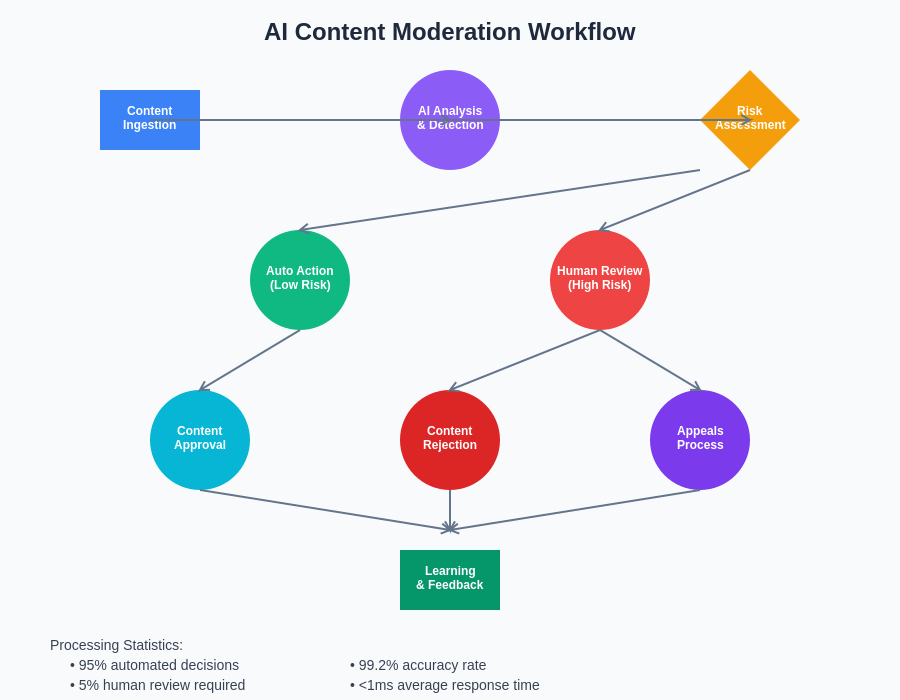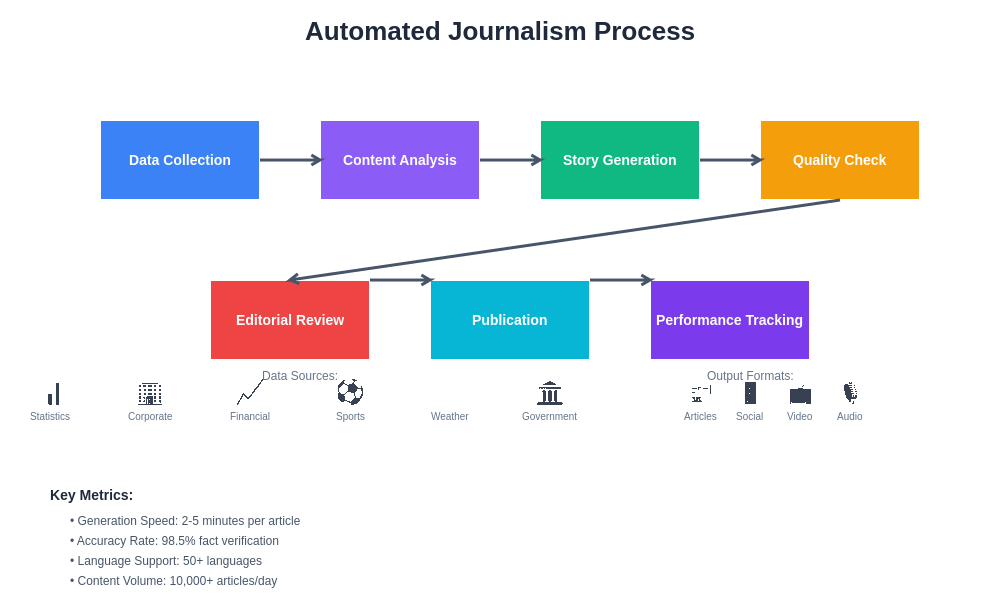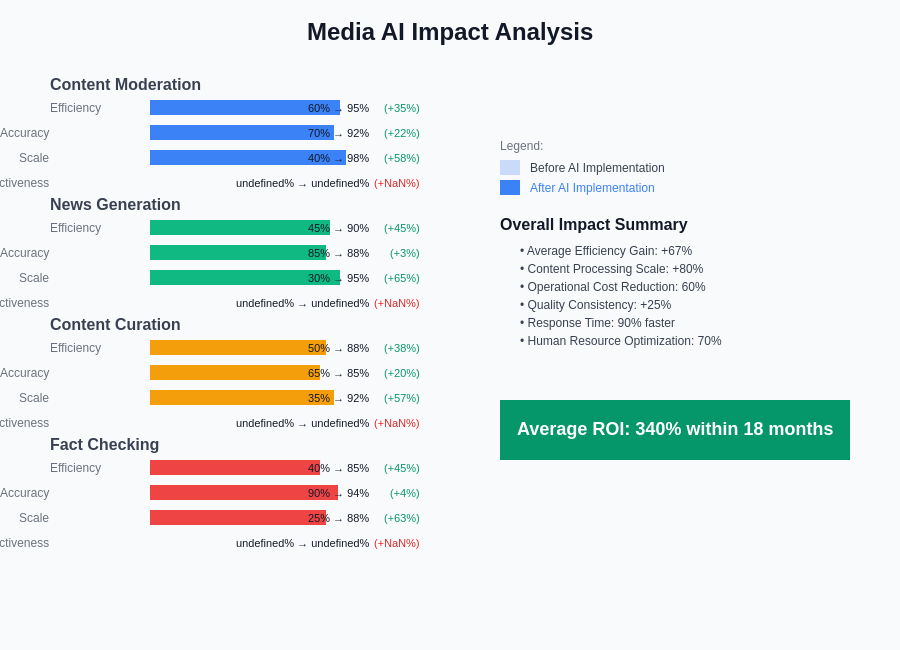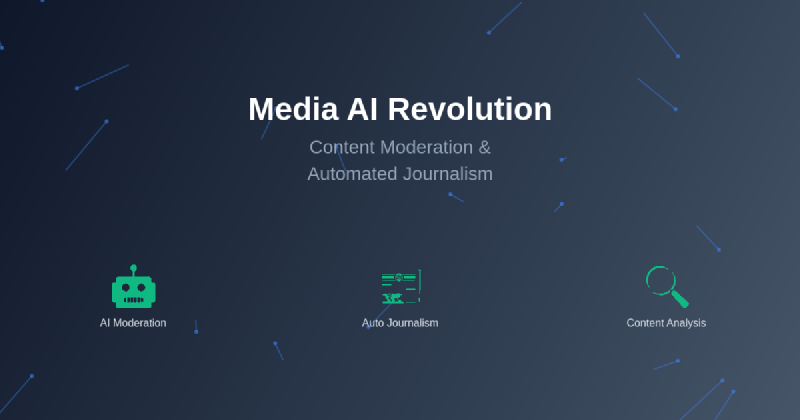The media landscape has undergone a profound transformation with the integration of artificial intelligence technologies, fundamentally altering how content is created, curated, moderated, and distributed across digital platforms. This technological revolution has introduced unprecedented capabilities in content moderation and automated journalism, creating new paradigms for media organizations while simultaneously presenting complex challenges related to accuracy, bias, and human oversight. The convergence of machine learning algorithms, natural language processing, and advanced analytics has enabled media companies to process vast amounts of information at scales previously unimaginable, while maintaining the quality and integrity standards that audiences expect from trusted news sources.
Discover the latest trends in AI-powered media to understand how artificial intelligence is continuously reshaping the landscape of digital content creation and distribution. The integration of AI into media operations represents more than mere technological advancement; it signifies a fundamental shift in how information is processed, verified, and delivered to global audiences in an era where the speed and volume of information flow have reached unprecedented levels.
The Evolution of AI-Powered Content Moderation
Content moderation has emerged as one of the most critical applications of artificial intelligence in the media industry, addressing the overwhelming challenge of managing user-generated content across platforms that serve billions of users worldwide. Traditional manual moderation approaches, while thorough, proved inadequate for handling the exponential growth of digital content, leading to the development of sophisticated AI systems capable of analyzing text, images, videos, and audio content in real-time. These systems utilize advanced machine learning models trained on extensive datasets to identify potentially harmful, misleading, or inappropriate content with remarkable accuracy and consistency.
The sophistication of modern AI moderation systems extends far beyond simple keyword filtering or basic pattern recognition. Contemporary solutions employ deep learning architectures that can understand context, detect subtle forms of harassment, identify manipulated media, and recognize emerging forms of harmful content that traditional rule-based systems might miss. These systems continuously learn and adapt to new threats, evolving their detection capabilities through exposure to diverse content patterns and feedback from human moderators who provide oversight and refinement to the automated processes.
The implementation of AI-powered content moderation has enabled media platforms to maintain safer environments for users while preserving the principles of free expression and open dialogue. By processing content at unprecedented speeds and scales, these systems can identify and address problematic material before it reaches large audiences, significantly reducing the potential for harm while maintaining the dynamic flow of information that characterizes modern digital media platforms.
Automated Journalism and News Generation
The emergence of automated journalism represents one of the most significant developments in modern media technology, enabling news organizations to generate high-quality articles, reports, and analyses without traditional human authorship. Advanced natural language generation systems can now process structured data from various sources, including financial markets, sports statistics, weather information, and government databases, to create coherent, informative, and engaging news content that meets professional journalism standards.
Enhance your understanding with Claude’s advanced AI capabilities to explore how sophisticated language models are revolutionizing content creation across industries. The technology underlying automated journalism extends beyond simple template filling, incorporating sophisticated understanding of narrative structure, audience preferences, and journalistic conventions to produce content that reads naturally and provides genuine value to readers.
Modern automated journalism systems demonstrate remarkable versatility in their ability to adapt writing styles for different audiences, publications, and content types. These systems can generate breaking news alerts with crisp, factual reporting, create detailed financial analyses with complex data interpretations, produce sports recaps with engaging narratives, and develop comprehensive reports on scientific findings with appropriate technical depth. The technology has proven particularly valuable for covering routine events, data-heavy stories, and time-sensitive news where speed of publication is crucial for competitive advantage.
The integration of automated journalism into newsroom workflows has enabled human journalists to focus on more complex investigative work, in-depth analysis, and stories requiring human insight, empathy, and creative interpretation. Rather than replacing human journalists, these systems serve as powerful tools that augment editorial capabilities and expand the scope of content that media organizations can produce within their existing resource constraints.
Advanced Content Analysis and Pattern Recognition
The application of artificial intelligence in media extends beyond content creation and moderation to encompass sophisticated analysis capabilities that can identify trends, detect emerging narratives, and provide insights into content performance and audience engagement. Advanced analytics systems powered by machine learning algorithms can process vast amounts of media content to identify patterns, themes, and connections that might not be apparent to human analysts working with traditional research methods.
These analytical capabilities have proven invaluable for media organizations seeking to understand audience preferences, predict content performance, and identify emerging topics before they become mainstream news stories. By analyzing social media activity, search trends, and content engagement patterns, AI systems can provide editorial teams with data-driven insights that inform content strategy decisions and help optimize resource allocation for maximum impact and audience reach.
The pattern recognition capabilities of modern AI systems extend to detecting coordinated inauthentic behavior, identifying potential disinformation campaigns, and recognizing manipulated media content such as deepfakes or doctored images. These capabilities have become increasingly important as digital media faces growing challenges related to misinformation, propaganda, and artificially generated content designed to deceive audiences.

The sophisticated workflow of AI-powered content moderation demonstrates the complex interplay between automated detection systems, human oversight, and continuous learning mechanisms that ensure both accuracy and adaptability in addressing evolving content challenges.
Real-Time News Processing and Distribution
The speed of modern information flow demands real-time processing capabilities that can analyze, verify, and distribute news content within minutes of events occurring. AI-powered news processing systems have revolutionized how media organizations handle breaking news, enabling automated fact-checking, source verification, and content distribution across multiple platforms simultaneously. These systems can monitor thousands of information sources, identify significant developments, and generate preliminary reports while human journalists focus on verification and additional reporting.
Real-time processing capabilities extend to multimedia content analysis, where AI systems can automatically generate captions for images, transcribe audio and video content, and create summaries of lengthy documents or press releases. This automation significantly reduces the time required to process and publish time-sensitive content while maintaining accuracy standards and editorial quality controls.
The integration of real-time AI processing has enabled media organizations to compete more effectively in an environment where audiences expect immediate access to information about developing stories. By automating routine processing tasks, news organizations can allocate human resources more strategically to activities that require editorial judgment, source cultivation, and creative storytelling approaches that differentiate their coverage from automated content.
Ethical Considerations and Human Oversight
The implementation of AI technologies in media operations raises significant ethical questions related to bias, transparency, accountability, and the preservation of human judgment in editorial decisions. Media organizations must carefully balance the efficiency gains provided by AI systems with the need to maintain editorial integrity, journalistic standards, and public trust in their content. This balance requires robust oversight mechanisms, clear ethical guidelines, and transparent disclosure of AI involvement in content creation and moderation processes.
Bias mitigation represents one of the most challenging aspects of AI implementation in media, as machine learning systems can inadvertently perpetuate or amplify existing biases present in their training data. Media organizations must implement comprehensive testing, monitoring, and adjustment procedures to ensure that AI systems operate fairly across different demographic groups, topics, and perspectives while maintaining the diversity of viewpoints that characterizes quality journalism.
Explore comprehensive AI research capabilities with Perplexity to understand the broader implications of artificial intelligence integration across various industries and applications. The responsibility for maintaining ethical standards ultimately rests with human editors and journalists who must provide oversight, make final editorial decisions, and ensure that AI systems serve the public interest rather than merely optimizing for engagement or efficiency metrics.
Multilingual Content Processing and Global Reach
AI technologies have enabled media organizations to expand their global reach through sophisticated multilingual content processing capabilities that can translate, localize, and adapt content for diverse international audiences. Advanced neural machine translation systems can now produce high-quality translations that preserve meaning, context, and cultural nuances while maintaining the original author’s voice and intent. These capabilities have democratized access to information across language barriers and enabled smaller media organizations to serve international audiences that were previously accessible only to large multinational corporations.
The sophistication of modern multilingual AI extends beyond direct translation to include cultural adaptation, local context integration, and region-specific content optimization. These systems can adjust references, examples, and cultural touchpoints to ensure that translated content resonates appropriately with target audiences while maintaining factual accuracy and editorial integrity. This level of localization was previously possible only through extensive human translation and cultural consultation processes that were prohibitively expensive for many media organizations.
Multilingual AI capabilities have proven particularly valuable for covering global events, international business news, and cross-cultural stories where accurate translation and cultural context are essential for audience understanding. By automating the initial translation and localization processes, media organizations can allocate human resources to fact-checking, cultural review, and editorial refinement while significantly expanding their content reach and audience engagement.
Personalized Content Curation and Recommendation
The explosion of available content across digital media platforms has created an overwhelming information environment where audiences struggle to find relevant, high-quality content that matches their interests and needs. AI-powered content curation and recommendation systems address this challenge by analyzing user behavior, preferences, and engagement patterns to deliver personalized content experiences that maximize relevance and satisfaction while exposing users to diverse perspectives and important information they might otherwise miss.
Advanced recommendation algorithms utilize sophisticated machine learning techniques that consider not only explicit user preferences but also contextual factors such as time of day, device type, location, and current events to optimize content delivery. These systems balance personalization with editorial priorities, ensuring that important news and diverse viewpoints receive appropriate visibility even when they may not align perfectly with individual user preferences.
The implementation of personalized curation systems has enabled media organizations to improve audience engagement, reduce information overload, and create more satisfying user experiences that encourage longer-term relationship building. By presenting relevant content at optimal times and in appropriate formats, these systems help media organizations compete more effectively for audience attention in an increasingly crowded digital landscape.

The comprehensive process of automated journalism demonstrates how artificial intelligence transforms raw data and information into polished, publication-ready content through sophisticated natural language generation and editorial workflow integration.
Quality Assurance and Fact-Checking Automation
The proliferation of misinformation and the increasing speed of news cycles have created unprecedented challenges for maintaining accuracy and credibility in media content. AI-powered fact-checking and quality assurance systems address these challenges by automatically verifying claims, cross-referencing sources, and identifying potential inaccuracies before content reaches audiences. These systems utilize vast databases of verified information, real-time data feeds, and sophisticated logical reasoning to assess the credibility of statements and identify potential red flags that warrant additional human review.
Modern fact-checking AI systems demonstrate remarkable sophistication in their ability to understand context, identify implicit claims, and recognize when statements require verification against authoritative sources. These systems can process claims in multiple languages, understand numerical relationships, and identify logical inconsistencies that might indicate errors or deliberate misinformation. The integration of these systems into editorial workflows has enabled media organizations to maintain higher accuracy standards while processing larger volumes of content.
The automation of initial fact-checking processes allows human fact-checkers to focus on complex claims that require investigative research, expert consultation, or nuanced interpretation. This division of labor maximizes the effectiveness of both automated systems and human expertise while ensuring that content meets professional journalism standards for accuracy and reliability.
Audience Analytics and Engagement Optimization
Understanding audience behavior and preferences has become crucial for media organizations seeking to maintain relevance and sustainability in competitive digital markets. AI-powered audience analytics systems provide unprecedented insights into content performance, user engagement patterns, and audience preferences through sophisticated analysis of interaction data, social media activity, and content consumption patterns. These insights enable media organizations to make data-driven decisions about content strategy, resource allocation, and audience development initiatives.
Advanced analytics systems can identify emerging trends in audience interests, predict content performance before publication, and recommend optimization strategies for improving engagement and reach. These capabilities enable editorial teams to balance audience preferences with journalistic priorities while maintaining editorial independence and professional standards. The insights provided by these systems help media organizations adapt to changing audience needs while preserving their core mission and values.
The integration of audience analytics into content creation workflows has enabled more strategic approaches to editorial planning, helping media organizations optimize their content mix to serve both audience interests and public information needs. By understanding which topics, formats, and presentation styles resonate most effectively with different audience segments, media organizations can improve their overall impact and sustainability.
Technical Infrastructure and Scalability
The implementation of AI technologies in media operations requires robust technical infrastructure capable of processing vast amounts of data, supporting real-time analysis, and maintaining high availability across global audiences. Modern media AI systems must handle peak traffic loads during major news events, process multimedia content efficiently, and maintain consistent performance across diverse geographic regions and device types. This technical complexity requires sophisticated cloud computing architectures, distributed processing systems, and intelligent resource management.
Scalability considerations extend beyond mere computational capacity to encompass data storage, network bandwidth, and integration with existing editorial and publishing systems. Media organizations must design AI implementations that can grow with their needs while maintaining cost efficiency and operational reliability. The technical architecture must also support rapid deployment of updates and improvements while maintaining stability and consistency in content processing and delivery.
The integration of AI systems with traditional media infrastructure requires careful consideration of compatibility, data flow, and workflow optimization. Successful implementations require collaboration between technical teams, editorial staff, and management to ensure that AI capabilities enhance rather than disrupt existing operational processes while providing clear benefits in efficiency, quality, and audience satisfaction.

The comprehensive analysis of AI impact across various media functions demonstrates the transformative effects of artificial intelligence on content creation, moderation, distribution, and audience engagement metrics.
Future Developments and Industry Evolution
The media industry continues to evolve rapidly as AI technologies advance and new applications emerge for content creation, curation, and distribution. Future developments in media AI are likely to include more sophisticated creative capabilities, improved emotional intelligence in content analysis, and enhanced integration with emerging technologies such as virtual and augmented reality. These advances will create new opportunities for storytelling, audience engagement, and media business model innovation.
The convergence of AI with other emerging technologies such as blockchain for content verification, 5G networks for enhanced multimedia delivery, and Internet of Things devices for news gathering will create new paradigms for media operations. These technological integrations will enable more immersive, interactive, and personalized media experiences while maintaining the accuracy, credibility, and ethical standards that audiences expect from professional journalism.
The evolution of media AI will require ongoing attention to ethical considerations, regulatory compliance, and public interest preservation. As AI capabilities become more sophisticated and pervasive in media operations, industry stakeholders must collaborate to establish standards, best practices, and oversight mechanisms that ensure technology serves the public good while supporting sustainable and innovative media business models.
The future of media AI promises to enhance rather than replace human creativity, judgment, and expertise in journalism and content creation. By automating routine tasks, providing powerful analytical tools, and enabling new forms of storytelling and audience engagement, AI technologies will empower media professionals to focus on the uniquely human aspects of journalism that provide the greatest value to society and democracy.
Disclaimer
This article is for informational purposes only and does not constitute professional advice regarding AI implementation in media operations. The views expressed are based on current understanding of AI technologies and their applications in the media industry. Readers should conduct their own research and consult with technical and editorial experts when considering AI implementation strategies. The effectiveness and appropriateness of AI systems may vary depending on specific organizational needs, audience characteristics, and regulatory requirements.
